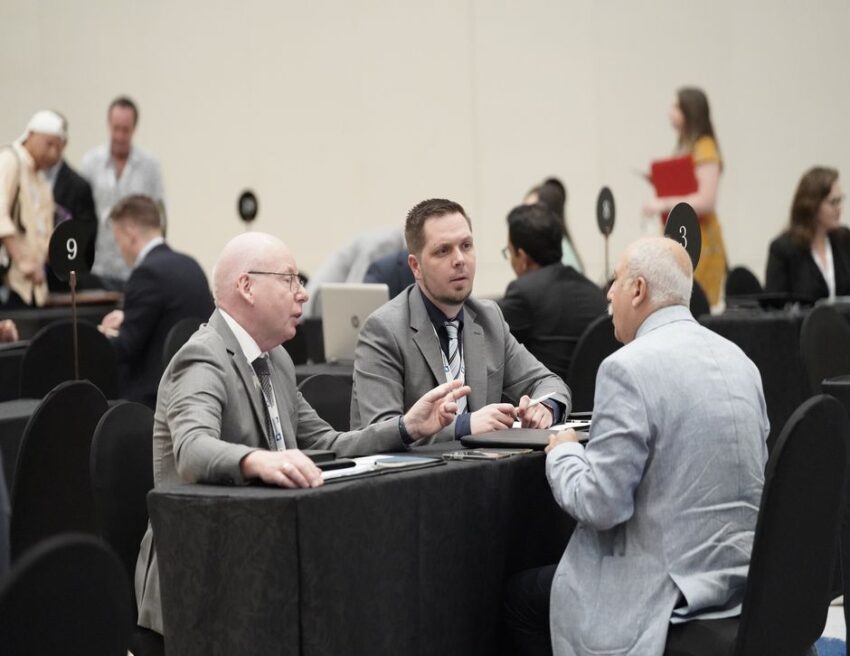Conqueror Freight Network’s 10th Annual freight forwarders conference, held in Bali, has successfully concluded, bringing together over 150 independent freight forwarders from around the world. With the conference now behind us, it’s crucial to develop an effective follow-up plan to kickstart upcoming projects. Expanding operations hinges on engaging in one-on-one discussions with your business partners. To truly maximize the impact of our Annual Meeting and foster long-term partnerships, post-event engagement is essential. Adopting a proactive approach to collaboration and relationship-building is important, as waiting for partners to take the initiative can result in missed opportunities. A well-crafted follow-up email can go a long way in strengthening the relationship with your partners and reach your business objectives.

How to write follow-up emails to your partners to seal a deal after attending a freight forwarders conference
-
The importance of writing a well crafted follow-up email to your logistics partners
Writing a well-crafted follow-up email to your logistics partners is essential for maintaining and strengthening professional relationships. In the fast-paced logistics industry, clear and timely communication is crucial to ensure smooth operations and project success. A follow-up email serves as a bridge between initial meetings or agreements and the actual implementation of plans. It demonstrates your commitment to the partnership and your attention to detail, helping to build trust and credibility. By summarizing key points, setting clear expectations, and outlining next steps, a follow-up email ensures that both parties are on the same page and that no important details are overlooked.
Moreover, a well-written follow-up email can significantly enhance collaboration and efficiency. It provides an opportunity to address any questions or concerns that may have arisen since the last communication, allowing for prompt resolution and preventing potential misunderstandings. Additionally, it reinforces your proactive approach and dedication to the partnership, which can encourage your logistics partners to reciprocate with the same level of engagement and responsiveness. In a highly competitive industry, these qualities can set your business apart and lead to stronger, more productive collaborations, ultimately driving mutual success and growth.
Tips for writing a follow-up email after attending Conqueror’s freight forwarders conference
A follow-up email after a meeting presents a valuable opportunity to solidify your role as a trusted partner and a source of beneficial ideas and information. This communication serves to reinforce the connection established during the meeting, demonstrating your commitment and reliability. By promptly following up, you show that you are attentive, organized, and dedicated to the mutual goals discussed. This not only enhances your professional image but also builds trust, as your meeting partner sees you as someone who values the partnership and is proactive in driving it forward.
When crafting a follow-up email, consider how you can use this medium to deepen the conversation you’ve already had. Reflect on the key points discussed during the meeting and expand on them, providing additional insights, resources, or suggestions that could further benefit your partner. This approach not only reinforces the topics covered but also demonstrates your willingness to go the extra mile. Personalizing the email to address specific concerns or interests mentioned in the meeting can make your follow-up more impactful and relevant. By doing so, you continue to position yourself as a valuable resource, fostering a stronger, more collaborative relationship that can lead to future opportunities and mutual success.
1. Be timely
Sending your follow-up email promptly after your freight forwarders conference or interaction is critical. A timely follow-up shows that you are attentive and serious about the partnership. Ideally, send your email within 24 hours to keep the conversation fresh and demonstrate your commitment.
2. Craft a clear subject line
Your subject line should be concise and directly related to the content of your email. A clear subject line helps your partner understand the email’s purpose at a glance. For example, “Follow-Up on Our Meeting – Next Steps” or “Summary and Actions from Our Recent Discussion.”
3. Start with a personal touch
Begin your email with a warm greeting and a personal note. Acknowledge the recent meeting or conversation and express your appreciation. For instance, “Thank you for taking the time to meet with me during Conqueror’s Annual Meeting. It was great to discuss our upcoming project.”
4. Recap key points
Briefly summarize the main points discussed during your meeting. This recap helps ensure that both parties are on the same page and serves as a reference for future actions. Highlight any decisions made, important topics covered, and agreed-upon next steps.
5. Clarify action items and deadlines
Clearly outline the action items that emerged from your discussion, specifying who is responsible for each task and any relevant deadlines. This clarity helps avoid misunderstandings and keeps the project moving forward efficiently.
6. Provide additional information
If there were any questions or topics that needed further exploration, use your follow-up email to provide additional information or resources. This can include relevant documents, links, or answers to questions that arose during your meeting. This not only adds value but also shows your proactive approach.
7. Express your commitment
Reaffirm your commitment to the partnership and the project. Let your partner know that you are available for any further discussions or clarifications. This reassurance helps build trust and underscores your reliability.
8. Invite further communication
Encourage your partner to reach out with any questions or additional thoughts. Keeping the lines of communication open fosters a collaborative atmosphere. For example, “Please feel free to contact me if you have any questions or need further clarification on any points.”
9. Close professionally
End your email with a professional closing that reflects your appreciation and eagerness to continue working together. A simple “Best regards” or “Looking forward to our continued collaboration” followed by your name and contact information is effective.
Sample follow-up email
Here’s a sample follow-up email incorporating these tips:
Subject: Follow-Up on Our Meeting – Next Steps
Dear [Network Partner’s Name],
Thank you for taking the time to meet with me yesterday. It was great to discuss our upcoming project and explore ways we can enhance our logistics operations together.
As a recap, we covered the following key points:
- Discussed the new shipping routes and their potential benefits.
- Agreed on the need for a revised logistics plan.
- Identified key performance metrics to track.
Action Items:
- I will send the updated logistics plan by Friday, June 10th.
- You will review and provide feedback by Wednesday, June 15th.
- We will schedule a follow-up call to discuss the feedback on Friday, June 17th.
Attached are the documents we discussed, including the preliminary route analysis and performance metrics outline.
I am committed to ensuring the success of our partnership and am here to support you in any way possible. Please feel free to reach out if you have any questions or need further clarification on any points.
Looking forward to our continued collaboration.
Best regards,
[Your Name]
[Your Position]
[Your Contact Information]
Wrapping up
By following these tips, you can craft effective follow-up emails that strengthen your relationships with logistics partners, clarify next steps, and keep your projects on track. Remember, a well-written follow-up email is not just a courtesy; it’s a strategic tool that can drive the success of your collaborations.


